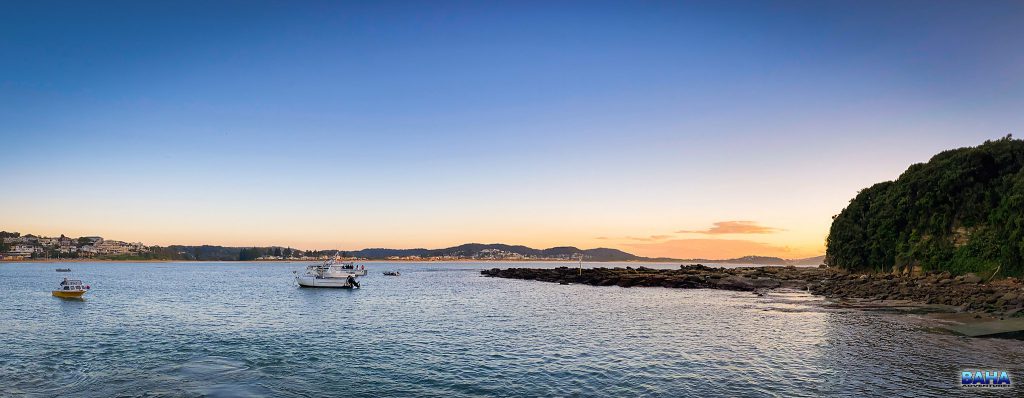Just over a month after starting my Advanced Open Water course I climbed into my car to head to Terrigal to finally complete it. Previously, poor weather had resulted in the second day of the course being cancelled, and I was itching to get back into the water to complete the training.
I’d collected my gear from Frog Dive on Saturday, which included testing and marking my nitrox tanks, for my Enriched Air Diver training. If I haven’t said it before, I’d highly recommend Frog Dive in Willoughby! The staff are incredible, and there’s a real sense of community in everything they do.
The early morning drive to Terrigal was amazingly beautiful, and I was left wondering why I hadn’t visited the area before. Sunrise over the bay was stunning, with the only downside being the lack of toilets. This saw me rushing to a clearly very frequently used bush to relieve myself, only to meet several other divers in the process.

Views from the Terrigal boat ramp at sunrise
Slowly the rest of the group arrived, which consisted mainly of the divers I started the course with, as well as a father son pair. Our instructor had changed, which saddened me, since Graham had run all of my courses up to this point, and we’d formed a good bond. That said, Ben was a great replacement, and I was incredibly impressed with his dive briefing and general attitude towards dive safety.
With the admin out of the way, and our gear all setup, we climbed onto the Prodive boat and headed out on the 10 minute run to the HMAS Adelaide. The HMAS Adelaide served the Australian navy for more than 20 years, before being sunk to form an artificial reef in March, 2011. The frigate is 183 meters long, and lies in 35 meters of water. The top deck sits at roughly 25 meters, while the top of the mast is under about 15 meters of water.
The wreck took a long time to be sink, as it was meticulously cleaned in order to minimise any impact on the ocean. This saw them removing all fluids (fuel, oil, etc), taking out the wiring, and even stripping the paint and markings off the vessel. As a result, internal navigation can be confusing, making it easy to get lost if penetrating – something I didn’t need to worry about on this trip.
After arriving at the wreck we were given another dive briefing by the captain, kitted up, and did our final buddy checks. For me this included setting my dive computer to the correct mix for my first nitrox dive. Based on my mix, I had a MOD (maximum operating depth) of 33 meters, which I tucked into the forefront of my memory.
We descended down the main mast, which was an incredible structure on it’s own, covered in coral and sponges, and home to a multitude of fish. Once we’d all reached the main deck, we gathered in a circle and spent some time looking at colours, both with and without a light, to see how they change at depth. We then compared our dive computers with our buddies, driving home some awareness of depth variance in these devices.
And then we headed out to explore. Despite the poor visibility (5 – 6 meters), it was obvious that the wreck was an incredible structure. Swimming over reefs, I feel like I’m diving. But swimming over a sunken ship, I felt like I was in space, floating over an abandoned, alien craft. Kingfish swirled far overhead, making me feel smaller.
Due to our dive floor being 30 meters, we only explored the main deck upwards. I was truly amazed by the incredible colour and variety of the corals and sponges covering the ship. The bright purple stood out most vividly in my mind. We also saw a lot of gorgeous parrot fish on the deck, an impressive blue groper, an abundance of scorpionfish, and a MASSIVE leatherbelly. It was interesting getting pulled towards (and pushed away from), the holes in the wreck by the surge.
Back on the surface we were taken back to shore, where we had a quick lunch while we waited for another group to dive the wreck. The wait was longer than expected, but a little under 2 hours later we climbed back onto the dive boat for the trip out to the HMAS Adelaide.
Our second dive on the HMAS Adelaide was our official wreck dive, and as such we got to do a lot more exploring. Visibility was still poor, and the water was greenish thanks to the recent rains. We again descended down the mast, dropped onto the main deck, and then swam along the corridors, swimming through rusted doors – it was absolutely epic. Eventually we reached the bow of the HMAS Adelaide, where we examined the hole left by the missile launcher, which had been removed before the ship was sunk. From there we headed to the very front of the wreck where we had our Titanic moment, before turning around and heading back towards the mast. On route we penetrated the bridge. I was amazed to find an old scuba tank mounted on the wall, with a glass front, and a bottle of Port stowed safely inside. Sadly, with our bottom time coming to an end, we headed back to the mast and ascended back to the surface.
What an incredible day! And one I’ll not quickly forget.
Being the last dive of the day, we helped take the dive boat out of the water, before heading back to the dive shop (via McDonalds) to complete all the necessary paperwork. I was finally an advanced diver – no not really – but that’s what the paper says.
